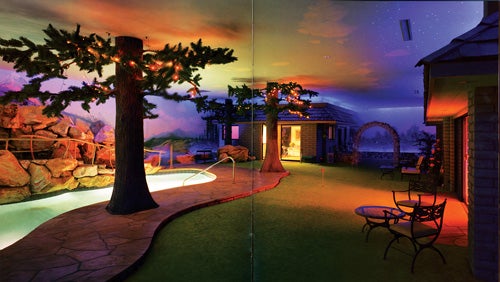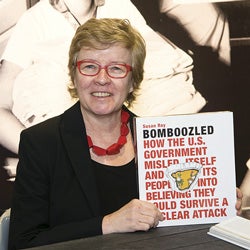Gimme Shelter

Susan Roy ’73 cut her journalistic teeth covering anti-war protests and women’s rights rallies in the early 1970s as a URI journalism major and staffer at The Good 5¢ Cigar. After a career with magazines such as Good Housekeeping, Self, This Old House, and Allure, she has returned to her radical roots with her first book, an illustrated history of Cold War paranoia.
Bomboozled: How the U.S. Government Misled Itself and Its People Into Believing They Could Survive a Nuclear Attack has generated a buzz in the media and publishing world, nabbing reviews and author profiles in The New York Times, The Atlantic, Publishers Weekly and the French language magazine AD France.
 A coffee table volume published by Pointed Leaf Press, the book combines Roy’s crisp prose with an eye-catching layout featuring her collection of pamphlets, photographs, government missives, and pop culture memorabilia relating to America’s fling with fallout shelters in the 1950s and 1960s. For anyone who lived through that era, leafing through the book will spark vivid memories of diving under desks during drills or breathing a sigh of relief when the announcer assured you that the buzzing from your TV set was “only a test” of the emergency broadcast system.
A coffee table volume published by Pointed Leaf Press, the book combines Roy’s crisp prose with an eye-catching layout featuring her collection of pamphlets, photographs, government missives, and pop culture memorabilia relating to America’s fling with fallout shelters in the 1950s and 1960s. For anyone who lived through that era, leafing through the book will spark vivid memories of diving under desks during drills or breathing a sigh of relief when the announcer assured you that the buzzing from your TV set was “only a test” of the emergency broadcast system.
Roy, who lives in Manhattan with her husband, Randall Rothenberg, became interested in fallout shelters during an architecture course at Columbia University when she ran across photographs of a shelter built to resemble a luxurious house 25 feet below the desert in Nevada. She did a paper on the shelter, designed by architect Jay Swayze for a client, Gerard B. Henderson. Roy built on the idea for her master’s thesis and ultimately her book.

The photos of that shelter are a highlight of the book. A two-page color spread shows the family room with sofas, lamps, carpeting, and sliding doors that lead to a “yard” with a fake green lawn. Exterior shots show a swimming pool, patio, guest house, lawn furniture, and artificial evergreen trees with lush lower branches and thick trunks that taper up and disappear into billowy white clouds painted above.
Roy’s book lifts a curtain on how the government tried to convince citizens that a nuclear nightmare would be little more than a speed bump in the American dream.
The first page shows a cut-away drawing of a “nuclear family” in a cozy underground home behind thick brick walls. Mom prepares dinner while dad reads a magazine and their daughter sets the table. “This one still makes me laugh every time I see it,” Roy said during an interview in New York.
But other illustrations are more sobering: a Collier’s magazine cover with a mushroom cloud entitled “Hiroshima, U.S.A.” and artist renditions of nuclear blasts destroying American cityscapes.
“The thesis started out being all about these structures,” Roy said. “Then I started wondering about the purpose, the history of civil defense.” Her project expanded, and she began to collect documents and information from the early days of Civil Defense.
In the early 1950s, “the government commissioned a study about how to communicate with Americans about the nuclear threat. At first they talked about what to do when the bomb hits. But then they decided to switch their approach to emotion management—getting people to think about how life would go on after the bomb hit. I looked at the archives. A lot of this stuff has never been published before.
“What the government was trying to do was basically a militarization of the population. It was a huge effort, and there is very little memory of it today.”
Roy believes the skills she learned at URI studying journalism with Professors David Anderson and Wilbur Doctor gave her the grounding to dig up the nuggets she found in all the documents and archives she sifted through and to tell a compelling story.
She called the early ’70s at URI, “a time when everyone was questioning the basic tenets of journalism. It was a lot of fun to be in journalism school then, as everyone was turning everything upside down.”
The Good 5¢ Cigar, which had replaced the more traditional Beacon as the campus newspaper, was part of the ferment. Roy immersed herself in chronicling the changing times with fellow staffers Anne Foster ’72, John Levesque ’72, David Bowers ’72, John Struck ’74, Catherine Winters ’73, John Pantalone ’71, John Geddes ’74, Larry Brusic ’73, Bill Loveless ’73, Alan Green ’74, and Marcia Holmes Green ’73.
“The Cigar was so much fun,” she recalled. “It was essentially an underground newspaper paid for by student fees. We had a women’s issue, I remember, and the state legislature tried to shut us down because that issue contained a controversial article with illustrations.”
Roy and fellow staffer Carol Cioe Klyman ’74 also did a gay issue, which she recalled was “quite a radical and daring thing to do” at the time. The writers did not use last names of their sources because “gays were completely closeted and faced massive discrimination and more.”
Roy recalls her days at the The Cigar as giving her the “the most editorial control of a publication I’ve ever experienced.”
“It was a great time to be studying journalism. Watergate happened when I was an undergraduate. There were a lot of other adventures too. A group of us drove down to New York to meet with the editors of Ms magazine, which had just started.” Roy also went to Washington to protest the bombing of Cambodia and to Boston to campaign for legalized abortion.
One big influence on Roy was Wilbur Doctor’s basic news writing class: “It was really great training because you had to do it in real time under the same conditions as an actual newsroom. It was great, practical, concrete, hands-on training.”
That training helped her forge a career in the Manhattan magazine publishing world and excel in the graduate work that resulted in Bomboozled. “One of the great things was that in journalism, you have to learn how to write clearly. Also, I was taught critical thinking in the URI Journalism Department.”
By David Gregorio ’80
 Home
Home Browse
Browse Close
Close Events
Events Maps
Maps Email
Email Brightspace
Brightspace eCampus
eCampus


